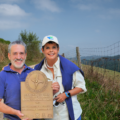San Adrián de Sásabe is a remarkable Romanesque church built at the confluence of two mountain ravines in a remote valley in the Pyrenees. According to experts, this church is all that remains of an entire Visigothic monastic complex. For centuries, San Adrián was forgotten and almost buried under rubble, but this place was very important in the Spanish High Middle Ages. According to tradition, the Holy Grail was hidden and guarded here for almost two hundred years.
The church of San Adrián has a peculiarity: water flows from its walls. This water enters through the staircase and, thanks to an ingenious system of channels, it flows back outside. It is as if the river literally flows in and out of the church. To enter this building silently, with the sound of water in the background, is an unforgettable experience.
This was not a miscalculation at all. The foundations of the church are not made of stone, but of juniper wood, a type of wood that maintains its consistency as long as it is in contact with water. It would be enough for the water to stop flowing for the building to collapse.
Through hidden valleys
Two letters written by King Martin the Humane, dated 1399, help us trace the Grial’s trail in Spain. In one of them, he asks the prior of San Juan de la Peña to hand him over the Holy Cup so that he can take it to Zaragoza. Before that, historians have to rebuild its itinerary based on other documents and oral traditions.
Most scholars claim that, when the Muslims arrived in the Peninsula in the year 711, the Grail was taken out of Huesca and hidden in different places in the Pyrenees. Since then, and for about four hundred years, bishops moved from one valley to another –for security reasons. Needless to say, they carried the precious relic with them everywhere they went.
Sásabe was the place where the Grail resided the longest during the dark times of the “aceifas” and the frontier wars. The monastery soon became the seat of the bishops of Huesca. In fact, the place is still a historical episcopal see –that is, there is still a bishop of Sásabe, although he obviously does not live there.
The Way of the Holy Grail connects all these places, following the route of the Grail from Huesca to Valencia. The Hermitage of Yebra de Basa, San Fructuoso de Bailo, Santa Cruz de Serós, San Juan de la Peña or San Pedro de Siresa are all well worth a visit.
But what about the water?
By why was this church built in such an inappropriate location? Hierophanies? Initiation rites linked to water? It does not seem very convincing that a Cluniac monastery, in which bishops resided, would incorporate Celtic pagan rituals, as some suggest.
A study published by Antonio García Omedes in Románico Aragonés points to several hypotheses. Two of them are quite suggestive. On the one hand, the church could be referring to the water that gushed from the House of God in the vision of the prophet Ezekiel.
Then he brought me back to the entrance of the temple, and there! I saw water flowing out from under the threshold of the temple toward the east, for the front of the temple faced east. The water flowed out toward the right side of the temple to the south of the altar. He brought me by way of the north gate and around the outside to the outer gate facing east; there I saw water trickling from the southern side. (Ez 47:1-2)
This vision was one of hope. After the first destruction of the temple in Jerusalem, Ezekiel had a vision of a new temple that would bring life where only ruins remained. The (rather apocalyptic) message was indeed quite appropriate –especially considering that Spain was being invaded at the time.
On the other hand, the water could refer to the monastery’s titular saint, Adrian of Nicomedia, a fourth-century martyr widely venerated by Mozarabic Christians.
Adrian, the son of the Roman emperor Probo, was brutally martyred in the presence of his wife, Saint Natalia. A legend says that after his death he appeared walking on water to guide and protect the ship in which Natalia fled with the relics of his body. The church would be a remnant of the alleged miracle.
Whatever the explanation, reaching this small enclave in the western Pyrenean valleys, next to the village of Borau, is worth a visit. Allow yourself to enjoy the peace, beauty, and harmony of this extraordinary combination of elements.





